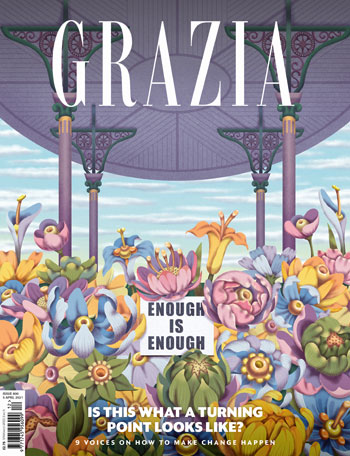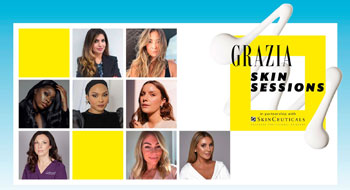
Hattie Brett believes there’s never been a more important time for women’s magazine brands. Disproportionately hit by the pandemic in terms of everything from carrying the brunt of childcare and home-schooling to dating and fertility insecurity to the greater likelihood of being furloughed, women need trusted voices to turn to. When you add in the crisis in mental health and the brutal fact that women still don’t feel safe on the streets, it’s no wonder that Grazia, a brand for 25 to 44-year-old women which she’s edited since 2018, has seen an upturn in readers over the last eighteen months.
“I think about all of those things going on in our woman’s life and it just crystallises why it’s so important that Grazia can champion her causes, fight for the issues that matter to her and effect real meaningful change on her behalf, but also make her feel understood and connected and less alone and bring her some escapism and joy,” says Brett.
Editing the magazine from home during lockdown with two small children was an experience she hopes never to repeat. But it was also a time during which Grazia found a new voice, pivoting quickly from weekly celebrity covers to become a fortnightly title shooting its own covers.
She admits: “It was really hard; it’s a time I hope we never have to do again. I was really lucky that there are a lot of working mums on my team. We all got used to seeing toddlers make an appearance and we pulled together as a team, supported each other and worked crazy hours. I’d do feature calls at 9pm when my features editor’s kids were in bed and mine were in bed. But we came through it.”
She adds: “To all intents and purposes, that first week of Covid should have been a disaster for Grazia, because we put a celebrity paparazzi image on the cover most of the time, so we had to pivot quite quickly to find our voice.”
We all got used to seeing toddlers make an appearance and we pulled together as a team, supported each other and worked crazy hours.
Switch to fortnightly
The decision to move from weekly to fortnightly publication came in May 2020. It has allowed Grazia – famously launched in 2005 as the first glossy women’s weekly – to behave more like a monthly magazine by creating thematic issues and making print more of an event. But the magazine still goes to press on the Friday before the following Tuesday, allowing it to be responsive if there’s a major news event.

“We’ve done that really successfully a few times, most recently when Sarah Everard was murdered and that outpouring of grief and trauma from women around the UK felt like a really important issue that we needed to talk to, so we literally ripped up our plans and we commissioned four illustrated covers and asked the question ‘Has this marked a turning point in the fight against violence against women?’ That newsiness which has always been in Grazia’s DNA gives us an advantage in the print market because we all know public mood and policy is shifting by the day if not by the hour right now. Being able to be responsive but also having the luxury of planning those thematic shot cover issues gives us the best of both worlds in print.”
Between January and June 2021, Grazia’s print circulation increased by 6.6% year-on-year to 86,413, while digital growth was up 87.3%. According to publishers Bauer Media, during the same period on Apple News, Grazia reached over 22million unique users, with just under 100,000 unique issue downloads and 1.3million minutes of engagement time from premium subscribers.
The Grazia reader is an ABC1 woman who is ‘savvy, smart and stylish’ but exceptionally time poor. She is looking for recommendations and edits when it comes to fashion, beauty and homeware, but also pieces that will help her to form opinions on the topical issues of the day, from Love Island to the cost of childcare.
Serious campaigning
Grazia has always been a campaigning magazine and during her editorship, Brett has spear-headed several influential campaigns. Recently, the brand teamed up with the activist group Pregnant Then Screwed to petition the government to commit to a review of the childcare system. The idea was born out of The Juggle, a mini community created by Grazia after they noticed that online parenting content was spiking in traffic from search and social.
Brett explains: “We wanted to be mindful of the fact that not all Grazia readers have kids, so creating a mini community of engaged Grazia type parents was a good solution. We launched it with accidentally brilliant timing on 4 January when parents were facing another lockdown.”
After an Instagram post about the cost of childcare attracted record levels of engagement, the Grazia team put a call out asking followers to tell them how they were managing. Within a few hours, they had received hundreds of comments.
“In Britain, we have the second most expensive childcare in the world, over 35 per cent of the average family’s income. It felt like there was something people were really struggling with here and that we could try and help,” says Brett.
They went on to launch the petition calling for an independent review into childcare and affordability which was debated in parliament after 100,000 people signed it in just one week.
The brand’s most recent campaign is around cyber-flashing. Grazia has joined forces with MPs Maria Miller and Jess Phillips to launch a cross-party petition for an amendment to the Online Safety bill. Again, the campaign came about from listening to their audience.
“We ran a piece with the actress Emily Atack last year where she talked about the onslaught of unsolicited sexual imagery that she was getting through social media and we were inundated with stories from readers saying the same thing had happened to them. As a team, we researched it and realised this was a big problem for millennial women. Forty-one per cent of them have been sent an unwanted image of a man’s genitals and nine in ten girls at school have been sent unwanted explicit images.”
Path to editorship
Magazine journalism is in Brett’s blood. Her father Nicholas Brett ran the BBC’s magazine portfolio and as a teenager, she was the inspiration for the launch of BBC History magazine (she studied history at university where she met her husband, a fellow historian). After graduating from a magazine journalism masters at Cardiff University, she joined Grazia as an editorial assistant. She left the title to launch and edit Bauer’s first digital-only brand The Debrief – “which was a lot of fun and an amazing learning experience to build something from scratch and to create a voice and a new identity for something”. From there, she joined the Daily Telegraph working across fashion and luxury in newsprint, digital and magazines.
“That was a really good experience both from seeing their exceptional digital and data team but also having that deep immersion into the fashion and luxury world. When I got the call about the Grazia editorship, it was in many ways a dream job. When I returned, because of the experience which I’d had since leaving, we were able to focus on the brand more than just the magazine.”
She adds: “My core belief as an editor is that you follow the audience and you have to have a really strong clear picture in your mind of who that audience is and what that audience needs from you and wants from you. Those two things are slightly different.”
To find out what it is the Grazia audience needs and wants, Brett combines instinct with insight. In the early days of lockdown, her team put a shout out on social media asking for 20 women to join a WhatsApp group. They used this instant focus group to ask the women how they were feeling about returning to shops, wearing masks and work life balance, as well as what they were watching on TV. The group is still going strong and the women have become good friends, with Grazia continuing to eavesdrop on their conversations.
There can be quite a lot of doomsaying in publishing, especially at the moment. That’s not something I buy into.
Staying positive
Last year, Brett was asked to become chair of the British Society of Magazine Editors.
“That was a real honour because it is still the only organisation solely for editors and senior editorial staff. At a time when the industry is changing so much and in flux, I think editors need access to a strong and supportive network.”
She wants to use the platform to celebrate magazine brands, firmly believing that there are still many passionate consumers of content out there.
“There can be quite a lot of doomsaying in publishing, especially at the moment. That’s not something I buy into,” she says.

Challenges faced by the industry include tackling the issues around fake news, as well as riding the uncertainty created by the coronavirus pandemic both in terms of supply chains and audience behaviour. Diversification is key, she believes and Grazia has embraced this with two podcasts as well as virtual events which have worked so well they will continue alongside in-person events in the future. In February, Grazia hosted its first ever virtual skincare festival, Grazia Skin Sessions, in collaboration with L’Oréal SkinCeuticals, a week of Zoom webinars with some of the most respected beauty experts and influencers.
“I am a big believer in collaborative activity that adds value to our audience but also for the brands that we’re working with. Our digital beauty events came from the insight that beauty has become more important to our audience and skincare specifically within that. We went to a brand that we felt shared authority in that space and devised a series of events that were very valuable to our audience but also worked for our clients. I believe that when you do it properly you shouldn’t have to sacrifice integrity for commercial partnerships.”
She concludes: “I feel very positive about the future of women’s magazine brands. What I think has been key to our success, especially over Covid, has been understanding our audience, going where she is, following her and bumping into her in credible ways.”
When you do it properly you shouldn’t have to sacrifice integrity for commercial partnerships.
This article was first published in InPublishing magazine. If you would like to be added to the free mailing list, please register here.












